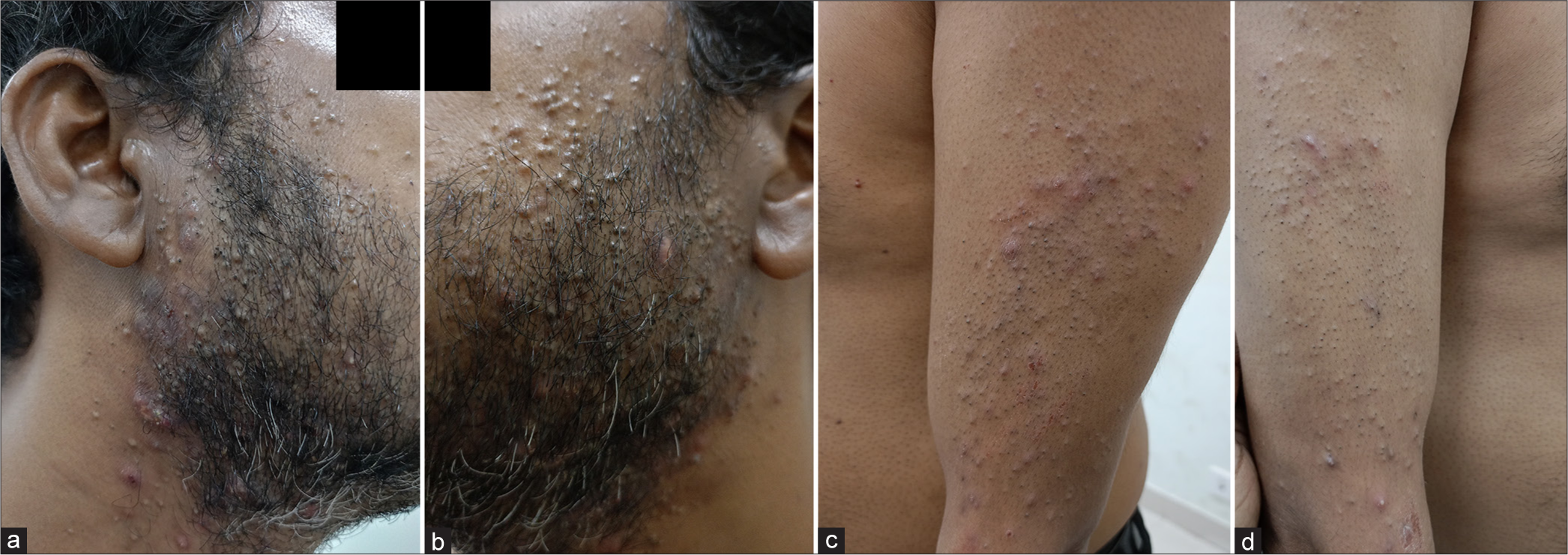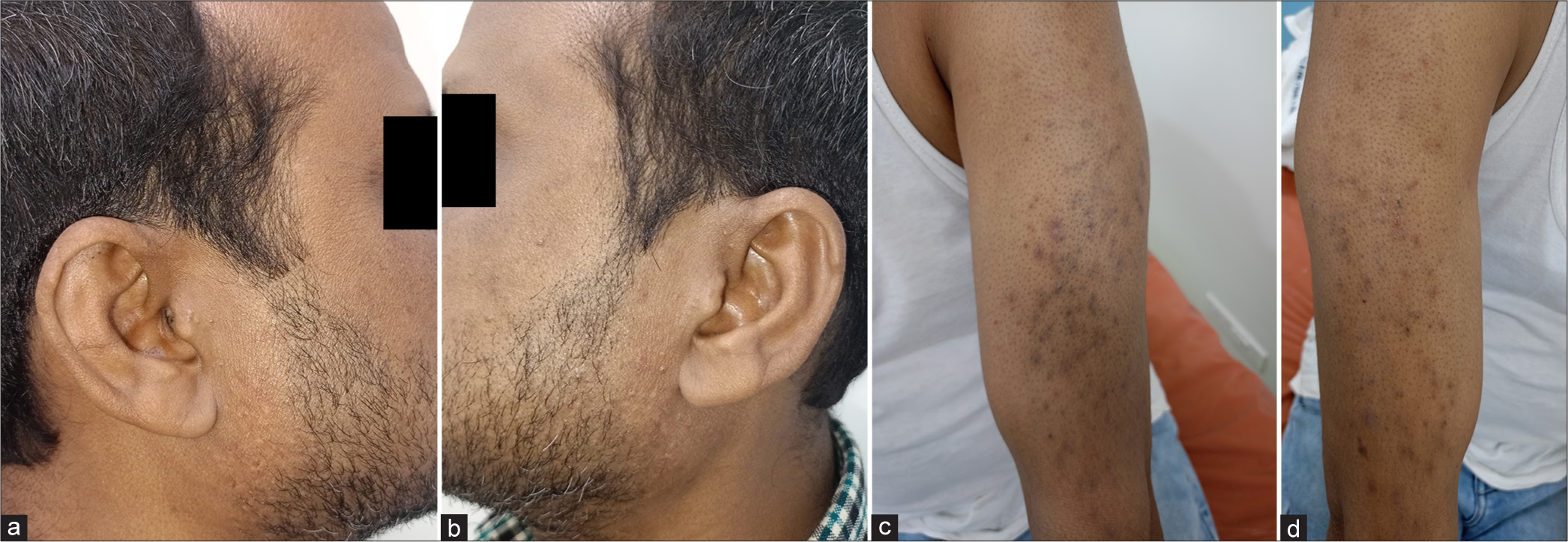Translate this page into:
A resistant case of chloracne successfully treated with azithromycin pulse

*Corresponding author: Avik Mondal, Department of Dermatology and Venereology, All India Institute of Medical Sciences, Kalyani, West Bengal, India. avik.mondal11@gmail.com
-
Received: ,
Accepted: ,
How to cite this article: Mondal A. A resistant case of chloracne successfully treated with azithromycin pulse. CosmoDerma. 2025;5:62. doi: 10.25259/CSDM_45_2025
Abstract
Chloracne is a rare disorder that presents as an acneiform eruption in patients working in the chlorine industry. Diagnosis of chloracne is difficult, mainly based on clinical history, temporal correlation, clinical manifestation, and biopsy along with immunohistochemistry. Treatment includes doxycycline and isotretinoin, which show variable results. Here, I report a case of chloracne in a patient working as a chlorophenol and chlorobenzene handler who showed no improvement with isotretinoin therapy and later completely improved with an azithromycin pulse.
Keywords
Azithromycin
Chloracne
Doxycycline
Isotretinoin
INTRODUCTION
Chloracne, an uncommon disorder, appears as comedones, pustules and cysts, induced by exposure to high concentrations of dioxins or polyhalogenated aromatic hydrocarbon compounds.[1-3] Although the term “chloracne” was coined by Herxheimer, Von Bettman first reported this eruption due to chlorine exposure.[1,2] However, McDonagh et al. mentioned it as a “misnomer” in view of the disappearance of sebaceous glands, reduced rate of sebum excretion, xerosis, and paucity of Propionibacterium acnes.[4] Diagnosis of chloracne is a difficult task, as measuring the chloracnegens in blood requires special laboratory techniques, and sometimes reports are not reliable due to the redistribution and metabolism of chloracnegens in the body.[5] Hence, diagnosis mainly depends on the clinical presentation and history of exposure. Sometimes histopathology gives clues toward diagnosis.[5] Due to its rarity, an appropriate treatment regimen is also lacking in the literature. There is no absolute cure. Prevention from further exposure is the mainstay of treatment. Sometimes, removal from exposure is not sufficient, as chloracnegens may persist in the body for long periods.[6] Some systemic drugs play a role in treatment, such as the tetracycline group, but often fail to produce the desired results. In addition, topical tretinoin and oral isotretinoin yield variable outcomes.[2] However, the latter two drugs remain the cornerstones in treating acne vulgaris.
CASE REPORT
An overall healthy, 42-year-old male patient, without any known comorbidity, presented with complaints of numerous open comedones, papules, and painful cysts over the face and bilateral arms for a duration of 1 year. On detailed history, he revealed that he is a worker in the chemical industry and has been handling chlorophenol and chlorobenzene products. Previously, he did not have any lesions; however, after entering this industry, he has been suffering. His lesions tended to improve to some extent when he took a week off, but they recurred when he returned to work for a few days. He visited a dermatologist, who diagnosed him with acne vulgaris. Initially, he was prescribed doxycycline 100 mg once daily for 2 months, but there was no improvement. This was then switched to isotretinoin 30 mg daily, which he has been taking for the past 3 months, yet there has been no noticeable effect.
On mucocutaneous examination, there were multiple skin-colored dome-shaped papules along with numerous open comedones, inflamed tender pustules, and cysts present over the lateral sides of the face involving predominantly around bilateral ears and beard areas extending to the neck, sparing the central face [Figure 1a and b]. Similar lesions also persisted symmetrically over bilateral arms [Figure 1c and d]. There were no oral mucosal or genital lesions. There was generalized xerosis, but no hypertrichosis, pigmentation, or palmoplantar hyperhidrosis was noted. Ophthalmological, neurological, and respiratory examinations were normal.

- (a and b) Picture showing discrete multiple skin-colored papules, large open comedones, pustules and inflammatory cysts over lateral sides of the face, around the ear and extending to the neck. (c and d) Picture showing symmetrical involvement of the bilateral arms in the form of numerous open comedones, erythematous papules, and pustules.
A 4 mm skin biopsy was taken, revealing keratinous follicular plugs and a neutrophil-predominant inflammatory infiltrate around the follicles, along with some noted reduction of sebaceous glands. A complete blood count, liver function tests, kidney function tests, and fasting lipid profile did not reveal any abnormalities. Based on his occupation, lesional morphology, and distribution, a diagnosis of chloracne was made.
In view of the lack of response to isotretinoin, azithromycin pulse therapy (azithromycin tablet 500 mg for 3 consecutive days every week for 3 months) was initiated, and isotretinoin was discontinued. The patient was advised to change his type of work or workplace, but he could not. However, there was a complete resolution of the skin lesions within 3 months [Figure 2a-d], and they were well-maintained on medication during further follow-up at 6 months without any adverse events. After that, azithromycin was stopped, and he is doing well off treatment.

- (a and b) Complete resolution of the face lesion after 3 months. (c and d) Complete improvement of the skin lesion over bilateral arms after 3 months with residual post-inflammatory hyperpigmentation.
DISCUSSION
Chloracne usually involves the malar area, retro-auricular area, sparing perioral area, and T-zone of the face, which can be sparsely present over the trunk and buttock.[1,7] It presents as sterile, polymorphous, large comedones, pustules, and cysts.[1,7] Usually, pustular inflammatory lesions on the neck are more pronounced in more severe cases.[4] These findings are compatible with our case.
In the 20th century, chlorinated phenols and benzenes (found in herbicides and insecticides) were the most common sources of chloracnegen contaminants, which are absorbed through the skin as well as by inhalation and ingestion.[1,2] Although the pathogenesis is poorly understood, dioxin causes oxidative stress, hyperkeratinization of keratinocytes and sebocytes, and activation of the aryl hydrocarbon receptor-cytochrome P450 1A1 pathway, all of which contribute to chloracne.[3]
In mild cases, if exposure to the chloracnegen ceases, the prognosis is quite favorable. For up to 2 years following exposure, the most severely affected individuals continued to develop new comedones; however, in most instances, the overall number of comedones and cysts gradually decreased over time.[2]
Although oral isotretinoin at a dose of 0.5-1 mg/kg/day is the ideal dose for treating severe acne and doxycycline 100 mg once daily for mild-to-moderate acne, the effects of these drugs remain uncertain in cases of chloracne.[2,5] On the other hand, the macrolide group of drugs, azithromycin, has anti-inflammatory action by inhibiting Prostaglandin E 2, tumor necrosis factor-alpha, and nitrogen oxides It also down-regulates neutrophil migration, reactive oxygen species production, and apoptosis.[8] Azithromycin 500 mg thrice weekly on consecutive days has been administered in some previous studies and proved to be effective in managing acne vulgaris.[8] However, it has not yet been tested for chloracne. This is the first case where azithromycin has been used for an uncommon condition like chloracne. However, a further large study is needed to conclude it as a first-line therapy.
CONCLUSION
Though chloracne is an uncommon and treatment-resistant disorder, azithromycin may serve as a safer and more effective alternative for treatment and long-term remission.
Ethical approval:
Institutional Review Board approval is not required.
Declaration of patient consent:
The author certifies that he has obtained all appropriate patient consent.
Conflicts of interest:
There are no conflicts of interest.
Use of artificial intelligence (AI)-assisted technology for manuscript preparation:
The authors confirm that there was no use of artificial intelligence (AI)-assisted technology for assisting in the writing or editing of the manuscript and no images were manipulated using AI.
Financial support and sponsorship: Nil.
References
- Three cases of suspected chloracne in a family from Pune. Indian J Dermatol Venereol Leprol. 2016;82:216-8.
- [CrossRef] [PubMed] [Google Scholar]
- Chloracne: Causation, diagnosis and treatment. J Dermatol Treat. 1991;2:73-6.
- [CrossRef] [Google Scholar]
- Therapeutic agents with AHR inhibiting and NRF2 activating activity for managing chloracne. Antioxidants (Basel). 2018;7:90.
- [CrossRef] [PubMed] [Google Scholar]
- Chloracne--study of an outbreak with new clinical observations. Clin Exp Dermatol. 1993;18:523-5.
- [CrossRef] [PubMed] [Google Scholar]
- Chloracne and chloracnegens. J Am Acad Dermatol. 1985;13:539-58.
- [CrossRef] [PubMed] [Google Scholar]
- Efficacy of azithromycin in treatment of acne vulgaris: A mini review. World J Plast Surg. 2019;8:127-34.
- [CrossRef] [PubMed] [Google Scholar]






